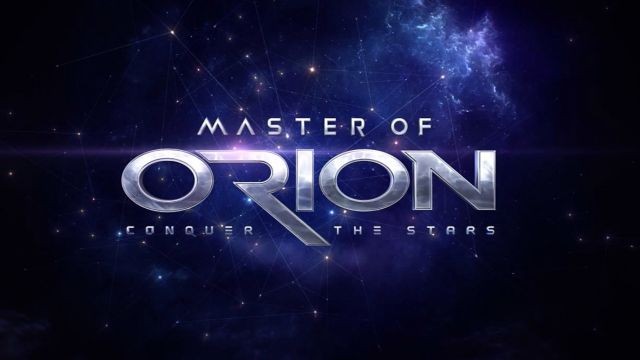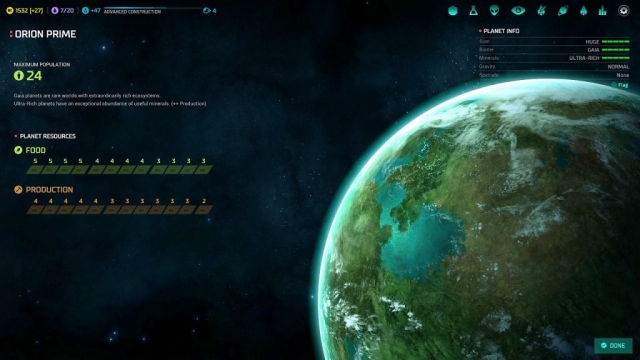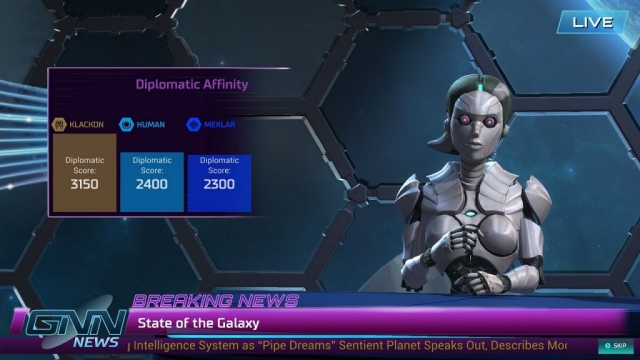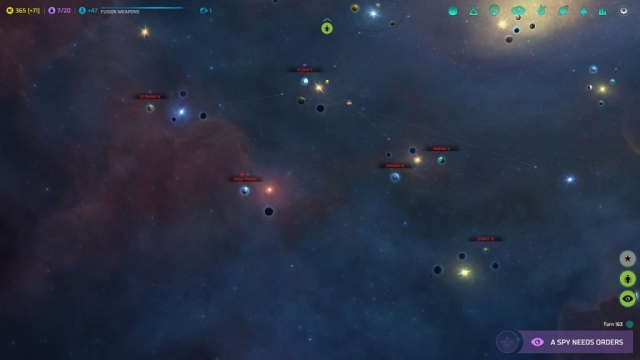Master of Orion: Conquer the Stars

The Good: Snazzy new graphics. Update of the original 4X I loved so much.
The Bad: Does little more than combine a lot of different bits of MoO1, MoO2, and MoO3 into one glossy package.
The Ugly: Spies have become a ridiculously burdensome, click-heavy activity. I’m not a big fan of real-time combat in my 4X. Mid and end game drag somewhat.
I’ve played an embarrassing amount of Master or Orion, referring of course to the 1993 version. Oh, it’s been a few years, maybe four or five since I last played it, but I mean, literally, I would be embarrassed if people knew how much I had played. Hours upon hours upon hours. Had I not played MoO so much, I likely could have cured cancer by now, written at least half a dozen more novels, and personally seen to it that neither Hillary Clinton nor Donald Trump would be running for president today. So, sorry about that, Earth.
I also played a lot of Civilization (by which I mean the 1991 version, for those youths who persist in congregating on my lawn despite my entreaties to depart), but Civ had a level of complexity to it that typically forced a long endgame. I can remember building about a million courthouses and tearing them down (because Civ had no direct way of converting production to cash), pumping out thousands of tanks and artillery (or spies, depending on my mood), and slowly, ever so slowly, consuming the map until finally finding and wiping out the last enemy and declaring victory. There were, I believe, other ways to gain victory (something about diplomacy, and maybe a scientific victory condition as well), but Civ games had a way of dragging out, the sheer magnitude of click work involved in maintaining dozens of cities.
MoO, the very first MoO, elegantly avoided most of that. Planets, which functioned much like cities in Civ, had a very few things you could choose to build – factories, population, ships, missile bases and income. That’s it, and the ratio of a planet’s GDP that went into those five things was determined by a series of five sliders. Set them and forget them – the planets ran themselves after that. The planets income could in turn be divided into savings, research, spying and entertainment (I feel as though I’m missing something in there, but I’m pretty close to correct). Endgames cruised right along, and while it was possible to achieve military victory by wiping out all your enemies, there was also periodically a galactic vote that was held, each race given a number of votes equivalent to the power they held in the universe, to determine which of the two most powerful races would be chosen supreme ruler. I would often achieve a very early victory by ingratiating myself to the third most powerful race, and with their votes could frequently have enough to win everything.
This is all a rather long-winded way of saying that I could finish an entire game of MoO in about half an hour give or take, except on huge maps. I almost never had a Civ game end in less than 6 hours, unless I was unceremoniously wiped out before that. Both games had a place in my life, but even as a graduate student it was easier to find a free half hour than it was to either find a contiguous open six-hour chunk or chain together a dozen half hour bits to play Civ.
MoO1 begat MoO2, and MoO2 begat MoO3, and the game became more complex and more mid and endgame sprawling, in short, more Civ-like, and I kept finding myself going back to the original (MoO3 as I recall also had some serious AI flaws that made the other races do illogical and game-breaking things). In a world of massive, byzantine, intensely detailed 4X games, MoO the first remained a quick 4X hit, a shot glass instead of a brandy snifter, a sprint instead of a marathon, a brief, torrid love affair instead of an enduring, soul-crushing marriage.
So, from the wreckage of the Atari bankruptcy, someone purchased the MoO intellectual property, and what have they done with it? For starters, they’ve given the entire thing a facelift, new menus and GUI. They’ve lifted a ton of the previous details – the tech tree remains nearly untouched, and the races in the game are identical. Even all the galactic events – the wealthy merchant who contributes to some race, the menacing space amoeba, the incipient supernova, even the GNN newsbreaks offering galactic insights – are still in there. Surface combat (invasions) remain as before. The galactic vote still takes place. I think the music is even the same.
Is there new stuff? Frankly, I’m not sure. I didn’t play MoO3 all that much, so maybe stuff that looks new to me was in that iteration. The game is more Civ-like, which makes you responsible for building individual structures on the planets to reduce corruption, enhance research, improve production, reduce civilian unrest, improve spaceship construction, defend the planet, and on and on. The mid and end game are rife with planet micromanagement that I typically came to MoO to escape.
The game now sports a real time space combat engine. When two space fleets meet, you’re given a probability of outcome, and you can let the computer just run it out based on the odds, or you can take the controls to try and do better yourself. I found the real-time control panel adequate, but nothing special, and if I’ve got to choose a real time space combat game I would prefer something like Homeworld, and liked the turn based approach of MoO.
The spy interface is nothing short of a burden. Spies are generated on a planet after you build the appropriate structure (spy school?). You’re notified by a popup when one is ready. You then have to open a panel (one click), select an enemy planet for them to do their work on (another click), pick a mission for them (a third click, and there are a lot of them to choose from), accept that mission (a fourth click), and then close the interface (a fifth click). I admit that I like the vast array of missions that you can send them on, and how missions build in risk as you try and accomplish more radical things, but when you have a dozen or more spies running around, this interface becomes exhausting. For the most part, I became so frustrated with the whole affair, that I just parked spies on planets and had them do nothing.
I don’t know. MoO scratched a very specific itch for me that no other 4X game has. This iteration of MoO:CtS doesn’t do it for me. I get that a lot of people are looking for a more involved, more detailed 4X experience, and my problem is not that I’m overwhelmed by all the activity in MoO. It’s just that if I’m looking for this kind of thing I have the excellent Civ V to turn to. It’s not that it’s bad, but except for a narrow slice of nostalgia, I don’t see what the new MoO:CtS brings to the table that the plentitude of other 4X games don’t.
Reviewed By: Phil Soletsky
Publisher: Wargaming.net
Rating: 70%
——————————————————————————–
This review is based on a digital copy of Master of Orion: Conquer the Stars for the PC provided by Wargaming.net.
 Game Over Online
Game Over Online







